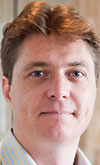
I once mistakenly credited President Jacob Zuma with having an underrated, though diabolical, sense of humour. That was back when he decided to split the former Department of Communications into a new, different Department of Communications with a different mandate, and the Department of Telecommunications and Postal Services. Naturally the two departments ended up with certain overlapping spheres of influence, and their respective ministers were at loggerheads from day one. It turned out Zuma was quite serious then, and serious too were the implications for our shambolic (and still unresolved) migration to digital terrestrial television.
Then he made his famous eleventy-thousand-8-million-hundred-3 speech and once again convinced me that this was a man with an uncanny mastery of the subtleties of self-satire. When Jeremy Clarkson, James May and Richard Hammond, of Top Gear fame, came to South Africa last year to shoot an episode of their new show, The Grand Tour, they regaled the studio audience with a video clip of said speech. So now the whole TV-watching world can laugh with us – or at us.
Thus, when I started hearing news about President Zuma’s latest – and in an ironic sense, perhaps his greatest – cabinet reshuffle, like Warren Muir (read his column in ‘From the chairman’s desk’) I clung to the hope that it was just an April Fool’s joke. Well, as it turns out, the punch-line is: South Africa gets ‘junk’ credit rating, the Rand plummets and thousands of businesses close their doors on 7 April in protest. Ha-ha-ha. At least he didn’t axe Dr Siyabonga Cwele, the Telecommunications and Postal Services minister, but come to think of it that’s a dubious upside.
Which brings me to another group of people not known for their sense of humour, and another topic which involves a sweeping out of the old and in with the new. Namely, engineers, and the evolution of the semiconductor industry towards a post-CMOS era. It’s premature to set the CMOS doomsday clock yet, but the International Roadmap for Devices and Systems (IRDS) puts it at circa 2024. The IRDS, which evolved out of the International Technology Roadmap for Semiconductors (ITRS), first published in 1965, has released a collection of nine new white papers that paint the clearest picture yet of where the semiconductor industry is headed, and what it needs to do to secure an unbroken pathway to ever more computing power. Those white papers are freely downloadable at http://irds.ieee.org/reports and they do not make for light reading – you have been warned.
The Semiconductor Industry Association (SIA) and Semiconductor Research Corporation (SRC) have also been hard at work putting together their own 73-page report entitled ‘Semiconductor research opportunities: An industry vision and guide’, which explores many of the same issues as the IRDS, albeit from a more US-centric point of view. This is to be expected given the SIA’s tagline of “representing US leadership in semiconductor manufacturing, design, and research” but the association does also publish valuable data on the global market.
John Neuffer, president and CEO of SIA, said at the launch of the report, “Our industry has pushed Moore’s Law to levels once unfathomable, enabling technologies that have driven economic growth and transformed society. Now, as it becomes increasingly challenging and costly to maintain the breakneck pace of putting more transistors on the same size of silicon real estate – industry, academia, and government must intensify research partnerships to explore new frontiers of semiconductor innovation and to foster the continued growth of emerging technologies.”

Lest we forget, the USA also has a laugh-a-minute septuagenarian for a president, one who’s inspiring just as much consternation in his country’s citizens and industries, and the semiconductor industry is no exception. Neuffer noted concern among the country’s technology, research and academic communities about proposed cuts to basic scientific research outlined in the Trump administration’s fiscal year 2018 budget blueprint. As he pointed out, “the US semiconductor industry supplements government investments by annually devoting about one-fifth of its revenue to R&D, more than any other sector.”
Aside from Donald Trump’s superior grasp of numbers, he and Jacob Zuma seem to share at least one common trait: a passion for building barriers. And luxury resorts.
Brett van den Bosch
| Tel: | +27 11 543 5800 |
| Email: | malckey@technews.co.za |
| www: | www.technews.co.za |
| Articles: | More information and articles about Technews Publishing |

© Technews Publishing (Pty) Ltd | All Rights Reserved